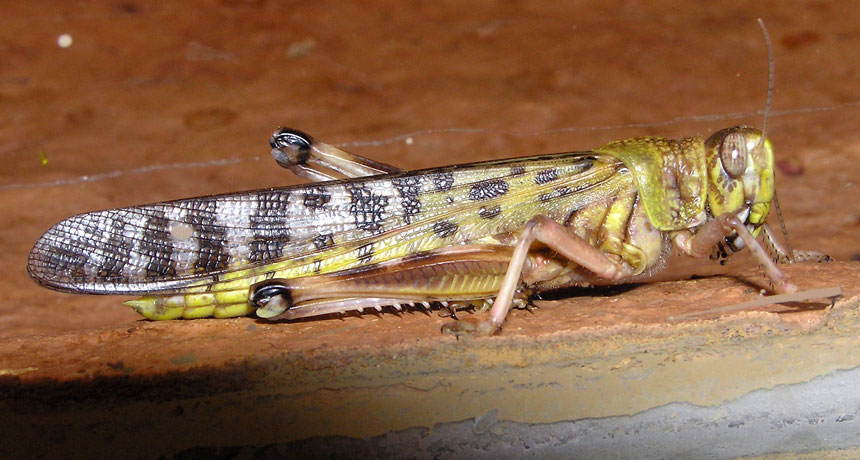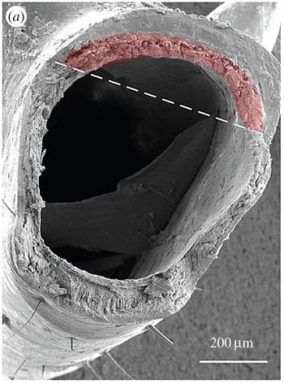Insects can patch their broken ‘bones’
By mending its external ‘skeleton,’ locusts regain about two-thirds of a leg’s original strength

Scientists cut into the big back legs of desert locusts. Afterward, the bugs patched their broken limbs to end up with legs that still were two-thirds as strong as before.
Arpingstone/Wikimedia Commons/Public domain
When a person breaks a leg, they might get a splint, cast or boot to cradle the bone as it heals. But what happens when a locust breaks a limb? Instead of a cast on the outside, the insect will patch itself up from the inside. These patches can restore up to 66 percent of a leg’s former strength, a new study finds.
The data also suggest new ideas for mending various types of pipes — from those in our homes to the living “pipes” inside our bodies.
Locusts and other insects rely on an exoskeleton — external support — made of cuticle (KEW-ti-kul). This material is made from a material called chitin (KY-tin). The cuticle has two layers. The outer one — or exocuticle (EX-oh-KEW-ti-kul) — is tough and can be very thick. It forms a protective armor. The inner layer — or endocuticle — flexes much more.
When cut, the cuticle forms a clot to seal off the wound. Then cells on either side of the cut secrete new endocuticle. The secretion spreads across and under the cut. Eventually it turns hard. This creates a thick patch on the inside.
While scientists understood that insects patched themselves this way, Eoin Parle realized that no one knew just how strong the repaired sites were. He decided to find out. Parle is a bioengineer — a scientist who uses engineering to study living things. He began this research while working at Trinity College Dublin in Ireland (he now works at University College in Dublin).
“There’s a lot to learn from the natural world,” Parle says. An insect’s cuticle, for instance, is very light and hard-wearing, he explains. Strong and stiff, it tends to be very tough, he adds.
Desert locusts (Schistocerca gregaria) roam Asia, Africa and the Middle East, where swarms of the critters can devastate farmers’ crops. This species became Parle’s test subjects.
Leaping locusts
He brought the bugs into his lab. “You always get a few raised eyebrows walking through the bioengineering facility with a cage full of locusts,” he notes. But the insects provide a good opportunity to study healing. Their back legs have to withstand strong forces when they jump. Those limbs offered a chance to study just how well the cuticle would mend.

To study what an injury would do, Parle carefully sliced into the legs of 32 locusts using a scalpel. Parle then let the legs heal. He left a further 64 locusts unharmed. They served as unaffected comparisons — or controls. Afterward, he measured leg strength in all of the bugs.
An injured leg lost about two-thirds of its former strength. In this state, Parle says, a locust risks snapping its leg right off during a jump.
After rest and repair, however, many of the locusts’ legs acquired a thick patch beneath the endocuticle. This mended the cut. Affected legs became about two-thirds as strong as they had been before the injury. That was good enough to let the bug safely resume jumping. As such, Parle concludes, that mending “is restoring fitness to the insect.”
Inspired by insects
Not all of the cuts healed, however. In fact, a bit fewer than half did. If the cut was jagged or too wide, cells around the wound could not secrete enough endocuticle to patch the gap. But Parle was surprised to find that even when cuts failed to heal, they didn’t get any bigger. The cuticle around them also did not crack.
This made the engineer wonder if cuticle-inspired materials might one day help make and repair pipes, such as those that carry water through a building. In pipes used today, a small crack can quickly grow and spread from the site of the initial break, he notes.
Parle thinks that an insect’s patch system might even inspire ways to repair burst blood vessels in people. Instead of stitches, we could “effectively restore strength and toughness by applying an internal patch,” he suggests. Parle and his colleagues published their findings April 6 in the Journal of the Royal Society Interface.
A study on broken locust legs is “exactly the kind of study we need,” says Marianne Alleyne. She was not involved with Parle’s research. Alleyne is an entomologist — someone who studies insects — at the University of Illinois in Champaign. “This is an exciting time to look at this stuff,” she says.
While it’s good to know locusts in a lab can heal busted limbs, no one knows if they also will do it in the wild. It took at least 10 days for a leg to heal. That’s a long time in the three-to-six-month lifespan of a locust.
“This proves they can do it,” Alleyne says. “But it doesn’t prove they do this in nature.” And, of course, when locusts do get injured in the wild, they probably don’t get a carefully controlled cut from a scalpel.
But Alleyne hopes that scientists might figure out how to use current technologies to make materials similar to an insect’s exoskeleton. Plumbing pipes would benefit from being made from something that could be patched and wouldn’t continue to crack when broken. A cuticle-like material is “self-patching and it’s recyclable,” Alleyne notes. She adds that it’s also pretty tough.
Power Words
(for more about Power Words, click here)
arthropod Any of numerous invertebrate animals of the phylum Arthropoda, including the insects, crustaceans, arachnids and myriapods, that are characterized by an exoskeleton made of a hard material called chitin and a segmented body to which jointed appendages are attached in pairs.
bioengineer Someone who applies engineering to solve problems in biology or in systems that will use living organisms.
bioengineering The application of technology for the beneficial manipulation of living things. Researchers in this field use the principles of biology and the techniques of engineering to design organisms or products that can mimic, replace or augment the chemical or physical processes present in existing organisms. This field includes researchers who genetically modify organisms, including microbes. It also includes researchers who design medical devices such as artificial hearts and artificial limbs. Someone who works in this field is known as a bioengineer.
bug Slang term for an insect. Sometimes it’s even used to refer to a germ.
carbohydrates Any of a large group of compounds occurring in foods and living tissues, including sugars, starch and cellulose. They contain hydrogen and oxygen in the same ratio as water (2:1) and typically can be broken down to release energy in the animal body.
chitin A tough, semi-transparent substance that is the main component of the exoskeletons of arthropods (such as insects). A carbohydrate, chitin also is found in the cell walls of some fungi and algae.
clot (in medicine) A collection of blood cells (platelets) and chemicals that collect in a small region, stopping the flow of blood.
control A part of an experiment where there is no change from normal conditions. The control is essential to scientific experiments. It shows that any new effect is likely due only to the part of the test that a researcher has altered. For example, if scientists were testing different types of fertilizer in a garden, they would want one section of it to remain unfertilized, as the control. Its area would show how plants in this garden grow under normal conditions. And that give scientists something against which they can compare their experimental data.
cuticle The tough but bendable protective outer shell or cover of some organism, or parts of an organism.
engineering The field of research that uses math and science to solve practical problems.
entomology The scientific study of insects. One who does this is an entomologist. A paleoentomologist studies ancient insects, mainly through their fossils.
endocuticle The inner layer of the cuticle, which is both tough and flexible.
exocuticle The outer layer of the cuticle, which is the outer shell of an organism. This layer is the toughest part of the cuticle.
exoskeleton A hard, protective outer body covering of many animals that lack a true skeleton, such as an insect, crustacean or mollusk. The exoskeletons of insects and crustaceans are largely made of chitin.
flex To bend without breaking. A material with this property is described as flexible.
insect A type of arthropod that as an adult will have six segmented legs and three body parts: a head, thorax and abdomen. There are hundreds of thousands of insects, which include bees, beetles, flies and moths.
pascal A unit of pressure in the metric system. It is named for Blaise Pascal, the 17th century French scientist and mathematician. He developed what became known as Pascal’s law of pressure. It holds that when a confined liquid is pressed, that pressure will b
recycle To find new uses for something — or parts of something — that might otherwise be discarded, or treated as waste.
secrete (noun: secretion) The natural release of some liquid substance — such as hormones, an oil or saliva — often by an organ of the body.
technology The application of scientific knowledge for practical purposes, especially in industry — or the devices, processes and systems that result from those efforts.
Editor’s Note: The article was updated on 5/10/16 to clarify the unit of pressure. It is megapascals.







